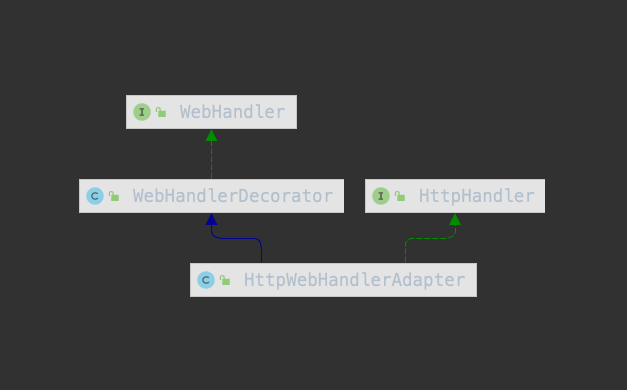Springwebflux源码学习-服务启动流程
文章目录
学习目标
- 理解WebFlux核心组件HttpHandler、WebHandler的创建过程
- 理解DispatcherHandler如何映射请求url及参数的过程
- 理解Netty服务的主要启动节点
此次学习的Spring boot版本为2.6.6,对应的Spring webflux版本为5.3.18
入口
Springboot工程入口方法为 SpringApplication.run() ,从此方法开始进行分析。
|
|
决定启动的web应用类型
整个服务的web应用类型是在构造 SpringApplication 类时进行确定的,具体代码如下:
|
|
判断应用类型的逻辑
- org.springframework.web.reactive.DispatcherHandler存在
- org.springframework.web.servlet.DispatcherServlet不存在
- org.glassfish.jersey.servlet.ServletContainer不存在
即确认webApplicationType为 Reactive
|
|
创建具体的ApplicationContext
根据webApplicationType(Reactive)确定创建的ApplicationContext为AnnotationConfigReactiveWebServerApplicationContext,此Context支持 @Component 和 JSR-330规范中 @Inject 形式的依赖注解
|
|
|
|
最主要的ApplicationContext.refresh()方法
refresh的Refresh阶段
刷新操作是在 AbstractApplicationContext 类的refresh方法中进行,在调用invokeBeanFactoryPostProcessors方法时会有对controller注解的扫描与处理
扫描Controller注解
ConfigurationClassPostProcessor.processConfigBeanDefinitions() 对Bean定义进行处理,此次研究只关注controller的处理, 具体的处理逻辑在 AbstractHandlerMethodMapping.initHandlerMethods() 方法中,最终调用的是 detectHandlerMethods() 方法,后续进行Handler方法的注册
|
|
-
Controller方法支持的条件
- patternsCondition
- methodsCondition
- paramsCondition
- headersCondition
- consumesCondition
- producesCondition
- customConditionHolder
-
注册Handler方法
AbstractHandlerMethodMapping调用MappingRegistry.register()进行Handler注册
1 2 3 4 5private final MappingRegistry mappingRegistry = new MappingRegistry(); protected void registerHandlerMethod(Object handler, Method method, T mapping) { this.mappingRegistry.register(mapping, handler, method); }
refresh的onRefresh阶段
createWebServer
在onRefresh阶段, AnnotationConfigReactiveWebServerApplicationContext的父类ReactiveWebServerApplicationContext进行了webServer的创建
|
|
- 创建webServer具体由WebServerManager类处理,WebServerManager中创建的httpHandler是Delayed,也就是延迟初始化的
-
获取BeanFactory
1ReactiveWebServerFactory webServerFactory = getWebServerFactory(webServerFactoryBeanName);获取到的Factory为 NettyReactiveWebServerFactory
-
创建HttpServer
主要逻辑在NettyReactiveWebServerFactory->getWebServer()方法中,在createHttpServer中看到了 HttpServer server = HttpServer.create();
1 2 3 4 5 6 7 8 9 10 11 12 13 14 15 16 17 18 19 20 21 22 23 24 25 26 27 28 29 30@Override public WebServer getWebServer(HttpHandler httpHandler) { HttpServer httpServer = createHttpServer(); ReactorHttpHandlerAdapter handlerAdapter = new ReactorHttpHandlerAdapter(httpHandler); NettyWebServer webServer = createNettyWebServer(httpServer, handlerAdapter, this.lifecycleTimeout, getShutdown()); webServer.setRouteProviders(this.routeProviders); return webServer; } private HttpServer createHttpServer() { HttpServer server = HttpServer.create(); if (this.resourceFactory != null) { LoopResources resources = this.resourceFactory.getLoopResources(); Assert.notNull(resources, "No LoopResources: is ReactorResourceFactory not initialized yet?"); server = server.runOn(resources).bindAddress(this::getListenAddress); } else { server = server.bindAddress(this::getListenAddress); } if (getSsl() != null && getSsl().isEnabled()) { server = customizeSslConfiguration(server); } if (getCompression() != null && getCompression().getEnabled()) { CompressionCustomizer compressionCustomizer = new CompressionCustomizer(getCompression()); server = compressionCustomizer.apply(server); } server = server.protocol(listProtocols()).forwarded(this.useForwardHeaders); return applyCustomizers(server); }
refresh的finishBeanFactoryInitialization阶段
设置DispatcherHandler
初始化WebHandler,也就是DispatcherHandler,因为DispatcherHandler实现了ApplicationContextAware接口,在加载Spring配置时,setApplicationContext方法会被调用,setApplicationContext主要做了统一分发策略的处理
- SimpleUrlHandlerMapping主要使用的handleMapping
- handlerAdapters
- resultHandlers
构建HttpHandler
HttpHandlerAutoConfiguration自动装配,调用WebHttpHandlerBuilder.applicationContext(this.applicationContext).build()构建真正的 HttpHandler
|
|
-
WebHttpHandlerBuilder.applicationContext()
Builder的通过context进行HttpHandler字段信息构建,主要包含以下字段信息
- webFilters 服务使用的过滤器
- exceptionHandlers 异常处理器
- sessionManager 会话管理器
- codecConfigurer 编解码配置
-
FilterChain的构建
WebHttpHandlerBuilder.build() 方法调用 new FilteringWebHandler方法进行DefaultWebFilterChain的创建,构建的FilterChain主要是用来对请求Filter的链式操作
1 2 3 4public FilteringWebHandler(WebHandler handler, List<WebFilter> filters) { super(handler); this.chain = new DefaultWebFilterChain(handler, filters); }
refresh的finishRefresh阶段
启动Server
终于看到服务的启动了,在调用链路 finishRefresh->getLifecycleProcessor().onRefresh()->DefaultLifecycleProcessor.startBeans()->doStart()
- initializeHandler初始化Handler为 HttpWebHandlerAdapter(WebHandler到HttpHandler的适配器)
- NettyWebServer.startHttpServer()
|
|
-
HttpWebHandlerAdapter

至此,服务准备就绪。
